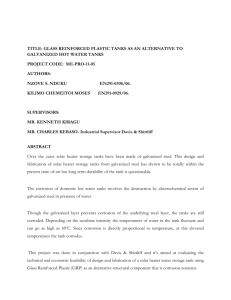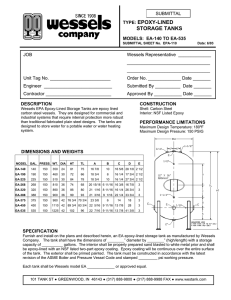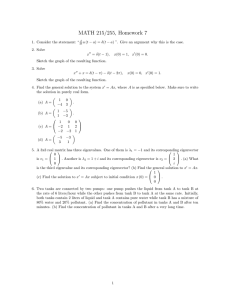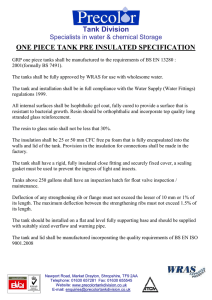rustproofing treatments for steel water tanks
advertisement
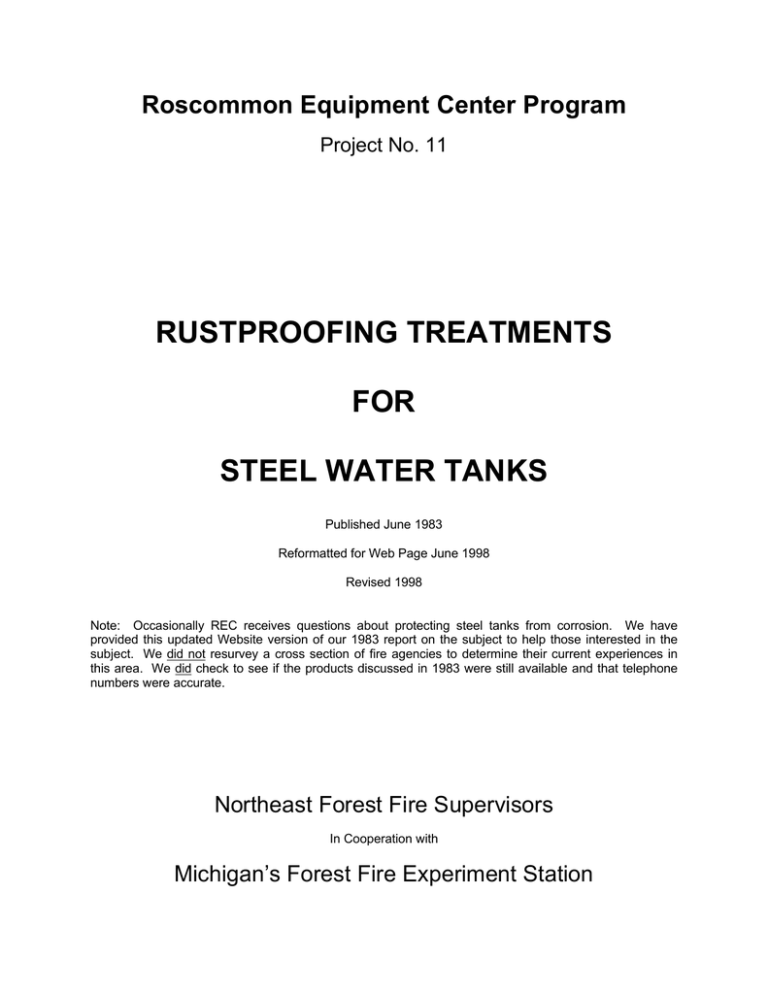
Roscommon Equipment Center Program Project No. 11 RUSTPROOFING TREATMENTS FOR STEEL WATER TANKS Published June 1983 Reformatted for Web Page June 1998 Revised 1998 Note: Occasionally REC receives questions about protecting steel tanks from corrosion. We have provided this updated Website version of our 1983 report on the subject to help those interested in the subject. We did not resurvey a cross section of fire agencies to determine their current experiences in this area. We did check to see if the products discussed in 1983 were still available and that telephone numbers were accurate. Northeast Forest Fire Supervisors In Cooperation with Michigan’s Forest Fire Experiment Station RUSTPROOFING TREATMENTS FOR STEEL WATER TANKS ROSCOMMON EQUIPMENT CENTER PROJECT NO. 11 CONTENTS Page Disclaimer.......................................................................................................................1 Introduction.....................................................................................................................2 Discussion ......................................................................................................................2 Interior Tank Coatings ....................................................................................................2 Rust Inhibiting Chemical Additives .................................................................................4 Sacrificial Anodes ...........................................................................................................4 No Treatment..................................................................................................................5 Summary ........................................................................................................................5 Disclaimer The information contained in this report has been developed for the guidance of employees of the member States, Provinces, Federal Agencies, and Cooperators. The NFFS assumes no responsibility for the interpretation or use of this information by those member organizations. The use of trade, firm or corporation names is for the information and convenience of the user. Such use does not constitute an official evaluation, conclusion, recommendation, endorsement, or approval of any product or service to the exclusion of others which may be suitable. 1 INTRODUCTION Steel water tanks have one major drawback – rusting. Over the years many attempts have been made, with little success, to slow the corrosive action within these tanks. The goal of this project is to identify the most promising and cost effective materials and/or treatments that will guarantee a reasonable life expectancy for a treated steel tank. The first question that comes to mind is: Why use steel tanks with their inherent rust problems when other tank materials are available? Although materials such as aluminum, fiberglass, polypropylene and stainless steel do not rust, each presents its’ own peculiar problems in tank construction. For example, aluminum is relatively weak, requires special welding equipment and is prone to joint fatigue. Fiberglass is often unsound for rugged, off-the-road use. In addition, algae formation can be a problem in waterfilled fiberglass tanks left in the sunlight for extended periods. Polypropylene requires special fabrication techniques. Stainless steel is an ideal material for the fabrication of water tanks, but requires a special welding process and is extremely expensive. Low cost, durability, availability, and ease of construction make steel a logical choice in the fabrication of water tanks. Most fire suppression organizations have access to shops with the necessary equipment to construct and maintain steel tanks. The large number of steel tanks presently in use guarantee that rust and corrosion will continue to be a problem for many years. DISCUSSION Three possible ways to deal with rust and corrosion problems in steel water tanks are: 1. Coat or treat inside tank surface with some substance. 2. Add rust-inhibiting chemicals directly to the water in the tank. 3. Add sacrificial anode – normally a magnesium rod – to reduce the corrosion rate of tank. 4. Do nothing at all and replace the tank when it rusts through. INTERIOR TANK COATINGS The Roscommon Equipment Center (REC) did not have the personnel or time available to test every type of rust protection product for water tank interiors. Past experience seemed to indicate that cold galvanizing compounds offer superior rust protection over most other products. Therefore REC concentrated research on cold galvanizing compounds. It is important to understand the difference between galvanizing compounds and paints. Paints work by sealing out moisture. Thus they retard corrosion by physically reducing or blocking moisture penetration and the subsequent oxidation of the iron. The major problem with sealing paints is that if the coating is scratched or wears off the iron or steel is once again subject to rusting. Galvanizing compounds both physically and chemically seal the tank from moisture penetration. Galvanizing compounds contain 95 percent pure zinc and 5 percent liquid binders. When a galvanized tank is scratched, pure unbonded zinc available in the coating forms a galvanic cell with the iron or steel. The newly formed insoluble zinc oxide coating prevents further rusting. As with other types of rust prevention coatings, surface preparation is the most important step when applying cold galvanizing compounds. Surfaces must be free of foreign material and scale for best 2 Return to Contents results. REC recommends using hot-rolled, pickled and oiled steel for fabricating new tanks. This type of steel has already had rust and scale removed at the mill through a phosphatizing process (phosphoric acid bath). This leaves the surface of the steel almost perfectly clean. The steel then receives a thin coat of protective oil which must be removed with a cleaner before treatment with the galvanizing compound. If older tanks are being retreated or there are heavy accumulations of rust on the surface to be treated, certain steps should be undertaken. REC recommends sandblasting followed by treatment with a phosphatizing agent before application of the galvanizing compound. Read carefully and follow exactly all label instructions. Two sources of galvanizing compounds are: ZRC Chemical Products Company 20 Newport Avenue Quincy, Massachusetts 02171 (617) 328-6700 ITW Devcon Danvers, Massachusetts 01923 1-800-933-8266 NOTE: Galvanizing compounds are not compatible with many wetting agents, foams and retardants. If you plan on batch mixing these products in the tank, consult with the manufacturer’s representative to insure that their coating is compatible with these products. Although REC is satisfied with cold galvanizing compounds, other types of products may be more suitable in certain situations. As mentioned before, galvanizing compounds may be a poor choice when wetting agents, foam or retardants will be used in the tank. When other types of coatings are used, tank surfaces must still be carefully prepared, preferably phosphatized, to insure satisfactory results. Once again, read and follow the manufacturer’s application recommendations exactly. Unsatisfactory results are most often attributable to failure to apply these products correctly. In the late 70’s, a cross sectional survey was conducted of various fire suppression organizations that use some type of interior tank coating. The majority of sources contacted either purchase or fabricate tanks with bolt-on lids. This feature allows easier maintenance of the interior coating, for worker access in repairing the tank and for thorough cleaning of the tank when severe siltation occurs. Several sources suggested that whatever coating is selected be sure it is compatible with the wetting agents or retardants you might use. Two coating products that were used successfully in the past by contacted agencies are still available in 1998. Product: Carbomastic (coal tar epoxy) Company: Carboline Co. 350 Hanley Industrial Court St. Louis, MO 63144 (314) 664-1000 Surface Preparation: Sandblasting or metal etching How Applied: Spray Duration: Unknown Compatible With: Wetting agents and retardants 3 Return to Contents Comments: Product: The application requirements must be strictly followed. It is one of the most expensive but also it is expected to last as long as most. Bisonite M Company: Pioma Coatings 470 Niagara Parkway North Tonawanda, NY 14120 (716) 693-6130 Surface Preparation: Sandblasting or metal etching How Applied: Spray or brush Duration: Unknown Compatible With: Wetting agents and retardants Additionally, Thomas Register of American Companies lists 174 companies offering coatings for tank protection. Look under “Tanks: Coatings”. Often, this resource is available at public libraries. Thomas Register can be located on the internet as thomasregister.com. The only conclusion that may be drawn from this information is that there are many products available at varying costs. Some organizations have had unsatisfactory experiences with several of the products, but they believe that the required application procedures might not have been followed by the fabricator. Everyone contacted emphasized the importance of closely following the manufacturer’s application recommendations. Surface preparation is critical. RUST INHIBITING CHEMICAL ADDITIVES These products are added to full water tanks when they will stand for long periods of time. The chemicals act to prevent or retard the oxidation process and may be used in both treated and untreated tanks. REC did very little testing of these products and the two products noted in our 1983 survey are unavailable now. Chemical additives are too expensive for an everyday solution to corrosion but can provide beneficial protection during long storage periods. SACRIFICIAL ANODES We have not used sacrificial anodes. These devices control corrosion by mounting a highly corrosible metal piece inside the tank. This metal, usually magnesium, becomes the anode of a galvanic cell when immersed and coupled to the steel tank. The anode corrodes at a high rate reducing the steel’s corrosion rate. It can be replaced when it becomes ineffective. Generally, they can be found in fire equipment catalogs or at tank service companies. Ask for advise as to the number and size needed for your size tank. 4 Return to Contents NO TREATMENT No treatment of water tanks may be the best solution in some cases. If this option is selected, REC recommends that the following procedures be observed. 1. Steel used for the tank should be at least 1/8 inch thick. Untreated tanks made with thinner steel will rust through too quickly to be economical. 2. Keep tanks as full of water as possible. When tanks are full, there is a reduced supply of free oxygen available and less rust forms as a result. 3. Tanks should be flushed periodically to prevent rust and scale from clogging the plumbing system. 4. If trucks are stored for winter with full tanks, some method should be used to take the weight off the springs and axles. 5. At the end of the fire season add rust inhibiting chemicals to the water before storing the truck for winter. Circulate water with chemical rust inhibitors through the tank and pump system if tanks are emptied for winter storage. SUMMARY No attempt was made to test all rust prevention products for this report. REC has identified what it considers to be the most effective and most widely used treatments by other fire suppression organizations. The preferred method of rust protection is some type of interior tank coating. REC has had excellent results with cold galvanizing compound. However, other types of coatings (epoxy resins, coal tar epoxies, polyurethane paint, etc.) may offer suitable protection in some cases. Careful preparation of the surface to be treated and strict adherence to the manufacturers’ application instructions are critical for success regardless of the coating used. The use, or anticipated use of wetting agents, foam, or retardant is also an important consideration when selecting a coating. 5 Return to Contents
